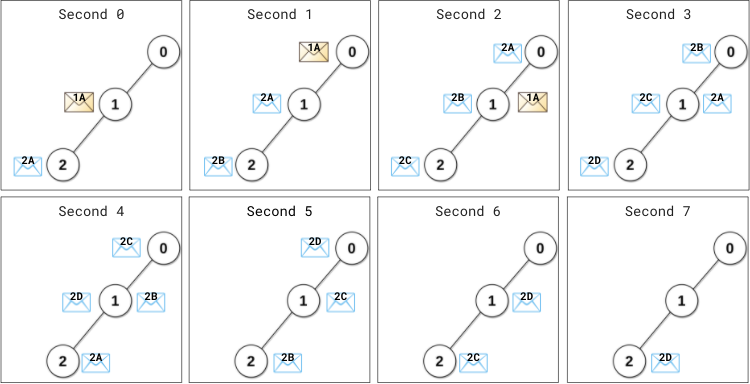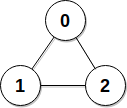- {x}
- Count Subarrays With More Ones Than Zeros
- Two Out of Three
- Minimum Operations to Make a Uni-Value Grid
- Stock Price Fluctuation
- Partition Array Into Two Arrays to Minimize Sum Difference
- Maximum Alternating Subarray Sum
- Minimum Number of Moves to Seat Everyone
- Remove Colored Pieces if Both Neighbors are the Same Color
- The Time When the Network Becomes Idle
- Kth Smallest Product of Two Sorted Arrays
- Accepted Candidates From the Interviews
- Check if Numbers Are Ascending in a Sentence
- Simple Bank System
- Count Number of Maximum Bitwise-OR Subsets
- Second Minimum Time to Reach Destination
- Sort Linked List Already Sorted Using Absolute Values
- Number of Valid Words in a Sentence
- Read More...

The Time When the Network Becomes Idle
There is a network of n servers, labeled from 0 to n - 1. You are given a 2D integer array edges, where edges[i] = [ui, vi] indicates there is a message channel between servers ui and vi, and they can pass any number of messages to each other directly in one second. You are also given a 0-indexed integer array patience of length n.
All servers are connected, i.e., a message can be passed from one server to any other server(s) directly or indirectly through the message channels.
The server labeled 0 is the master server. The rest are data servers. Each data server needs to send its message to the master server for processing and wait for a reply. Messages move between servers optimally, so every message takes the least amount of time to arrive at the master server. The master server will process all newly arrived messages instantly and send a reply to the originating server via the reversed path the message had gone through.
At the beginning of second 0, each data server sends its message to be processed. Starting from second 1, at the beginning of every second, each data server will check if it has received a reply to the message it sent (including any newly arrived replies) from the master server:
- If it has not, it will resend the message periodically. The data server
iwill resend the message everypatience[i]second(s), i.e., the data serveriwill resend the message ifpatience[i]second(s) have elapsed since the last time the message was sent from this server. - Otherwise, no more resending will occur from this server.
The network becomes idle when there are no messages passing between servers or arriving at servers.
Return the earliest second starting from which the network becomes idle.
Example 1:

Input: edges = [[0,1],[1,2]], patience = [0,2,1] Output: 8 Explanation: At (the beginning of) second 0, - Data server 1 sends its message (denoted 1A) to the master server. - Data server 2 sends its message (denoted 2A) to the master server. At second 1, - Message 1A arrives at the master server. Master server processes message 1A instantly and sends a reply 1A back. - Server 1 has not received any reply. 1 second (1 < patience[1] = 2) elapsed since this server has sent the message, therefore it does not resend the message. - Server 2 has not received any reply. 1 second (1 == patience[2] = 1) elapsed since this server has sent the message, therefore it resends the message (denoted 2B). At second 2, - The reply 1A arrives at server 1. No more resending will occur from server 1. - Message 2A arrives at the master server. Master server processes message 2A instantly and sends a reply 2A back. - Server 2 resends the message (denoted 2C). ... At second 4, - The reply 2A arrives at server 2. No more resending will occur from server 2. ... At second 7, reply 2D arrives at server 2. Starting from the beginning of the second 8, there are no messages passing between servers or arriving at servers. This is the time when the network becomes idle.
Example 2:

Input: edges = [[0,1],[0,2],[1,2]], patience = [0,10,10] Output: 3 Explanation: Data servers 1 and 2 receive a reply back at the beginning of second 2. From the beginning of the second 3, the network becomes idle.
Constraints:
n == patience.length2 <= n <= 105patience[0] == 01 <= patience[i] <= 105for1 <= i < n1 <= edges.length <= min(105, n * (n - 1) / 2)edges[i].length == 20 <= ui, vi < nui != vi- There are no duplicate edges.
- Each server can directly or indirectly reach another server.
Solution Explanation:
This problem involves finding the earliest time when a network of servers becomes idle after processing messages. The network consists of a master server (server 0) and several data servers. Each data server sends a message to the master server, which processes it and sends a reply. Data servers resend their messages periodically if they haven't received a reply within their patience time. The network is idle when no messages are in transit or arriving.
The solution uses Breadth-First Search (BFS) to efficiently determine the shortest paths from each data server to the master server. This shortest path determines the time it takes for a message to reach the master server and return.
Algorithm:
-
Graph Construction: Build an adjacency list representation of the network using the
edgesarray. This allows for easy traversal using BFS. -
BFS Traversal: Perform a BFS starting from the master server (node 0). During the traversal:
- Keep track of the distance (
d) from each server to the master server. The distance represents the time it takes for a message to reach the master. - Mark visited servers to avoid cycles.
- Keep track of the distance (
-
Calculating Idle Time: For each data server (
i):- The round-trip time for a message is
2 * d[i]. - The last send time before receiving the reply is calculated as
(2 * d[i] -1 ) / patience[i] * patience[i]. This ensures we get the last multiple of patience time before the reply arrives. - The time when the server finally receives the reply is
(2 * d[i] -1 ) / patience[i] * patience[i] + 2 * d[i]. - The
+ 1accounts for the instant processing at the master server before the reply is sent. - The maximum of all these final receive times is the earliest time the entire network becomes idle.
- The round-trip time for a message is
Time Complexity: The BFS traversal takes O(V + E) time, where V is the number of vertices (servers) and E is the number of edges. The subsequent calculation of idle time for each data server takes O(V) time. Therefore, the overall time complexity is O(V + E), which is linear in the size of the network.
Space Complexity: The space complexity is dominated by the adjacency list (O(V + E)) and the vis array (O(V)), and the queue used in BFS (at most O(V)). Thus, the overall space complexity is O(V + E).
Code Implementation (Python):
from collections import defaultdict, deque
class Solution:
def networkBecomesIdle(self, edges: List[List[int]], patience: List[int]) -> int:
n = len(patience)
graph = defaultdict(list)
for u, v in edges:
graph[u].append(v)
graph[v].append(u)
distances = [-1] * n
distances[0] = 0
queue = deque([0])
while queue:
u = queue.popleft()
for v in graph[u]:
if distances[v] == -1:
distances[v] = distances[u] + 1
queue.append(v)
max_idle_time = 0
for i in range(1, n):
round_trip_time = 2 * distances[i]
last_send_time = (round_trip_time - 1) // patience[i] * patience[i]
max_idle_time = max(max_idle_time, last_send_time + round_trip_time + 1)
return max_idle_time
The code in other languages (Java, C++, Go, TypeScript) follows a similar structure, adapting the data structures and syntax to the respective languages. The core algorithm remains the same.